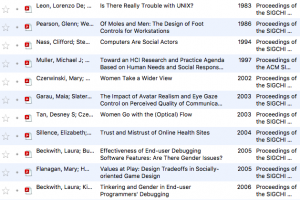Understanding users become increasingly complicated when we grapple with various overlapping attributes of an individual's identity. As a term, the user now represents an expanding, diverse set of people. In this work, we introduce intersectionality as a framework for engaging with the complexity of users'-and authors'-identities, and situating these identities in relation to their contextual surroundings. We conducted a meta-review of identity representation in the CHI proceedings, collecting a corpus of 140 manuscripts on gender, ethnicity, race, class, and sexuality published between 1982-2016. Drawing on this corpus, we analyze how identity is constructed and represented in CHI research to examine intersectionality in a human-computer interaction (HCI) context.
We chose intersectionality, a framework that focuses on how various dimensions of identity (e.g., gender, race, and class) coalesce inseparably and relate to the conditions of one's surroundings because it supports efforts to situate the relationship between technology and social systems. In situating these relationships, we believe this work can help HCI's broader agenda to do the right thing, within and outside third wave research. Our goal is to provide HCI researchers with empirical insight into current identity representation practices in CHI as well as to develop principled insights and recommendations for advancing the representation of identity in HCI.
We find that previous identity-focused research tends to analyze one facet of identity at a time. Further, research on ethnicity and race lags behind research on gender and socio-economic class. From these findings, we developed recommendations for incorporating intersectionality in HCI research broadly, encouraging clear reporting of context and demographic information, the inclusion of author disclosures, and deeper engagement with identity complexities.

In the last decade, computing has left the office and entered people's domestic and recreational lives. Consequently, computing affects our lives shaping not just how we work, but also how we play. Moreover, computing potentially allows individuals to blur the boundaries by letting us conduct domestic routines while in the office, or working from a cafe in an urban centre. Researchers in the work to play lab are interested in using a variety of empirical techniques to advance the state of the knowledge in how computing affects our lives from work to play.
Past research has laid the foundation for the work2play lab by examining communication and coordination in both work and recreational settings. Whether communicating via email or coordinating action through a shared repository, people use computational technologies to interact with each other. The study of interaction, in work and play settings, has built a foundation of knowledge that work to play researchers can use to understand how computing is beginning to cut across these aspects of our lives.
Following Human-Centered and Human-Computing we conduct field studies, develop insights, deploy ICTs and evaluate impact.



